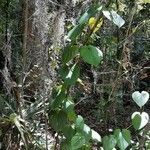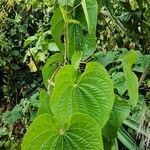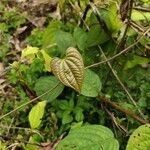Plants tuberous or not; tubers, when present, buried just below ground surface, not stalked, globose, weighing less than 1 kg. Stems twining counter-clockwise, climbing to more than 20 m, often flecked with purple, unwinged or rarely narrowly winged, terete, producing axillary bulbils frequently greater than 5 cm in diam. in leaf axils. Leaves alternate throughout, 5–25 × 5–26 cm; petiole usually somewhat shorter than blade, base clasping, basal lobes stipulelike, 1–4 mm wide; blade 5–11-veined, broadly ovate-cordate, glabrous, base orbicular, margins entire, apex long-acuminate. Staminate inflorescences axillary, borne singly, spicate or paniculate, cymose, to 70 cm; cymes reduced to 1 sessile bracteolate flower, internodes ca. 2 mm; secondary axes to 6 per node, fasciculate, subtended by deltate bracteoles or sometimes leafy bracts, 3–20 cm. Pistillate inflorescences borne singly or fasciculate, to 6 per axil, spicate; spikes bearing to 50 flowers, 6–40 cm, subopposite to 8 mm apart. Staminate flowers fragrant; perianth white, becoming purple; tepals in 2 similar whorls, spreading at anthesis, lanceolate, (1–) 2–5 mm; fertile stamens 6 in 2 equal whorls; anthers as long as or longer than filaments; thecae distinct, not spreading. Pistillate flowers: perianth greenish white, not changing color; tepals as in staminate flowers; staminodes 6, smaller than fertile stamens. Capsules not reflexed at maturity, longer than wide, 1.8–2.8 × 1–1.5 cm. Seeds unilaterally winged, 12–20 mm. 2n = 80, 100.
Tubers usually solitary, renewed annually, ovoid or pear-shaped, 4--10 cm thick; cork black; roots fibrous. Stem twining to left, glabrous, smooth. Bulblets purplish brown with orbicular spots, globose or ovoid, variable in size, weight to 300 g. Leaves alternate, simple; petiole 2.5--5.5 cm; leaf blade broadly cordate, 8--15(--26) × 2--14(--26) cm, glabrous, margin entire or slightly undulate, apex caudate-acuminate. Male spikes usually clustered in leaf axils or along leafless, axillary shoots, drooping, sometimes branched. Male flowers: solitary, ± contiguous along rachis; bract and bracteole ovate; perianth purple, lobes lanceolate; stamens 6, inserted at base of perianth, filaments nearly as long as anthers. Female spikes often 2 or more together, similar to male ones, 20--30 cm. Female flowers: staminodes 6, ca. 1/4 as long as perianth lobes. Capsule reflexed or drooping, straw-colored, densely purplish dotted, oblong-globose, 1.5--3 cm, glabrous, base and apex rounded; wings 0.25--0.7 cm wide. Seeds inserted near apex of capsule, dark brown; wing pointing toward capsule base, oblong, 1.2--1.6 × ca. 0.5 cm. Fl. Jul--Oct, fr. Aug--Nov.
A yam with a long smooth stemmed vine, round in cross section. It winds to the left. It does not have spines. The vine can climb up into trees and grow to long lengths. The leaves are large and round. They are pointed at the tip and round at the base. About 7 veins arise from the tip of the leaf stalk. Leaves can be 14-30 cm across and slightly longer than wide. This yam produces bulbils (potatoes) in the angles of the leaves along the vine. These are often flattened and can be grey brown or purple. Under the ground it has a smaller tuber normally covered with roots. The flowers are large. The male flowers are in spikes up to 20 cm long. The female spikes are usually in pairs. The fruit are winged and about 2.5 cm long by 1.5 cm across. The seeds have wings. The bulbils normally have few fibres through the tissue compared to some yams tubers. The flesh of many varieties is yellow.
Tuber globose, pear-shaped or turnip-shaped. Stems twining, to 4 m long, terete to slightly ridged, glabrous. Bulbils subglobose, ellipsoidal or cylindroidal, to 7 cm diam., usually verrucose. Leaves: lamina ovate, 5–30 cm long and wide, cordate at base, acuminate at apex, 7–11-veined, glabrous; petiole 2–15 cm long. Male flowers: spikes 2–6 per axil, to 5 cm long, often in large branched inflorescences; sepals and petals oblong to narrowly ovate, 2.5–3 mm long, white turning purple-brown; stamens 6. Female flowers: usually in spikes to 35 cm long, 2–5 spikes per axil; perianth slightly smaller than male; staminodes 6. Capsule oblong to obovate in lateral view, 18–30 mm long, glabrous; lobes 6–7 mm wide. Seeds 4–5 mm long; wing 6–10 mm long.
Tuber perennial, usually irregularly subglobose, but occasionally elongate, and sometimes absent.. Plant glabrous or the leaf-blade inconspicuously puberulous at the base beneath.. Twining stems up to 12 m. long.. Leaves as in 3, D. asteriscus.. Aerial tubers irregularly subglobose or markedly angular, up to 7 cm. in diameter, brown.. Inflorescences as in D. asteriscus, except that the ♂ flowers are sessile and directed downwards, towards apex of inflorescence.. Perianth lobes of ♂ flower not spreading; tepals lanceolate, up to 2 mm. long.. Perianth lobes of ♀ flower directed towards apex of inflorescence, up to 2 mm. long.. Capsule and seeds similar to those of D. asteriscus, but capsule only 2 cm. long and 1.2 cm. in diameter.
Some edible cultivated varieties with large leaves have lost their ability to produce flowers, the bulbils are then larger and composed of a larger number (4-5) of buds. Wild varieties with toxic, angular, greyish bulbils and medium-sized leaves occur and others with small purplish bulbils, small leaves with a red base to the petiole.
Tubers renewed annually, globose, absent in several varieties or according to the method of cultivation
Female flowers, when produced, white turning pink and then purple when old.
Bulbils 1-8 cm. in size, toxic or edible according to the variety
Glabrous non-spiny climber 10-20 ft. high









